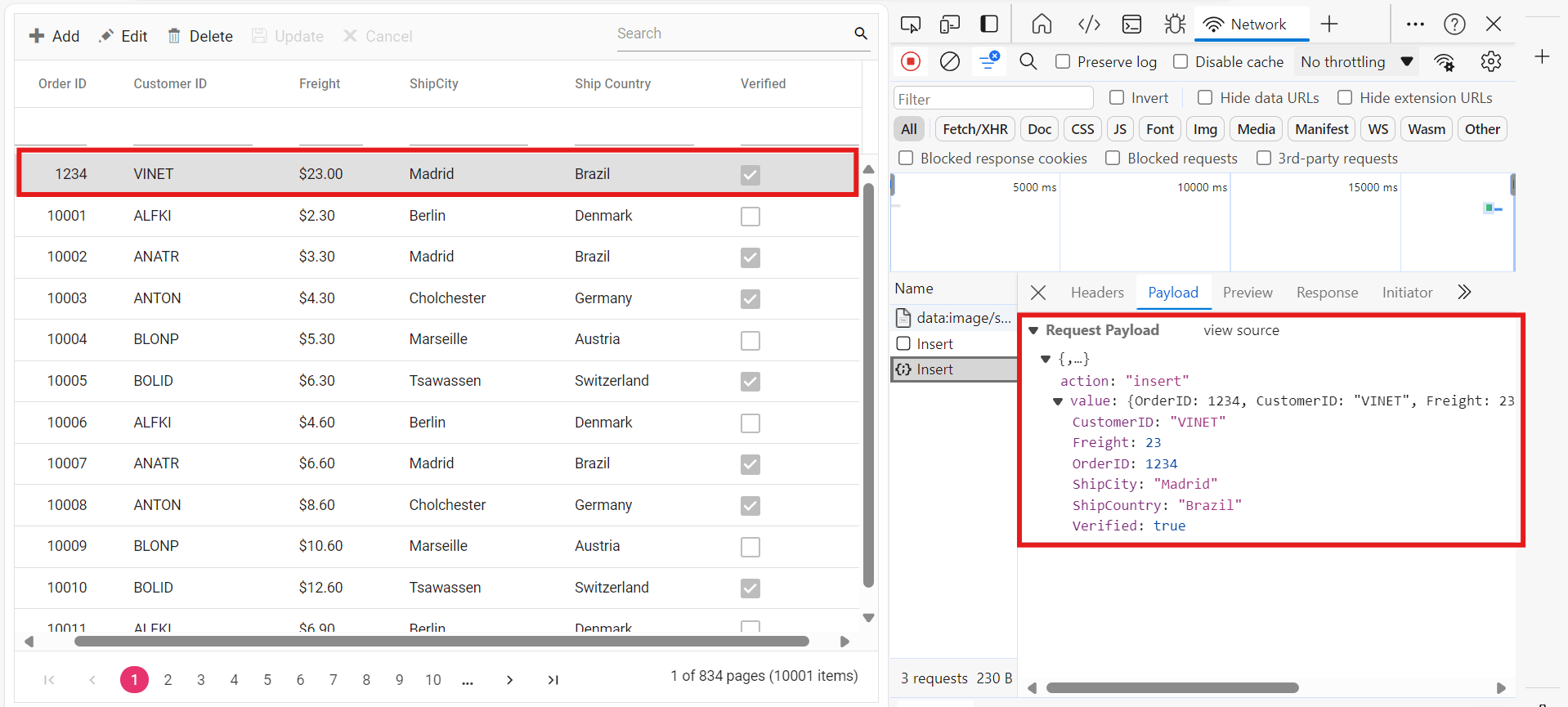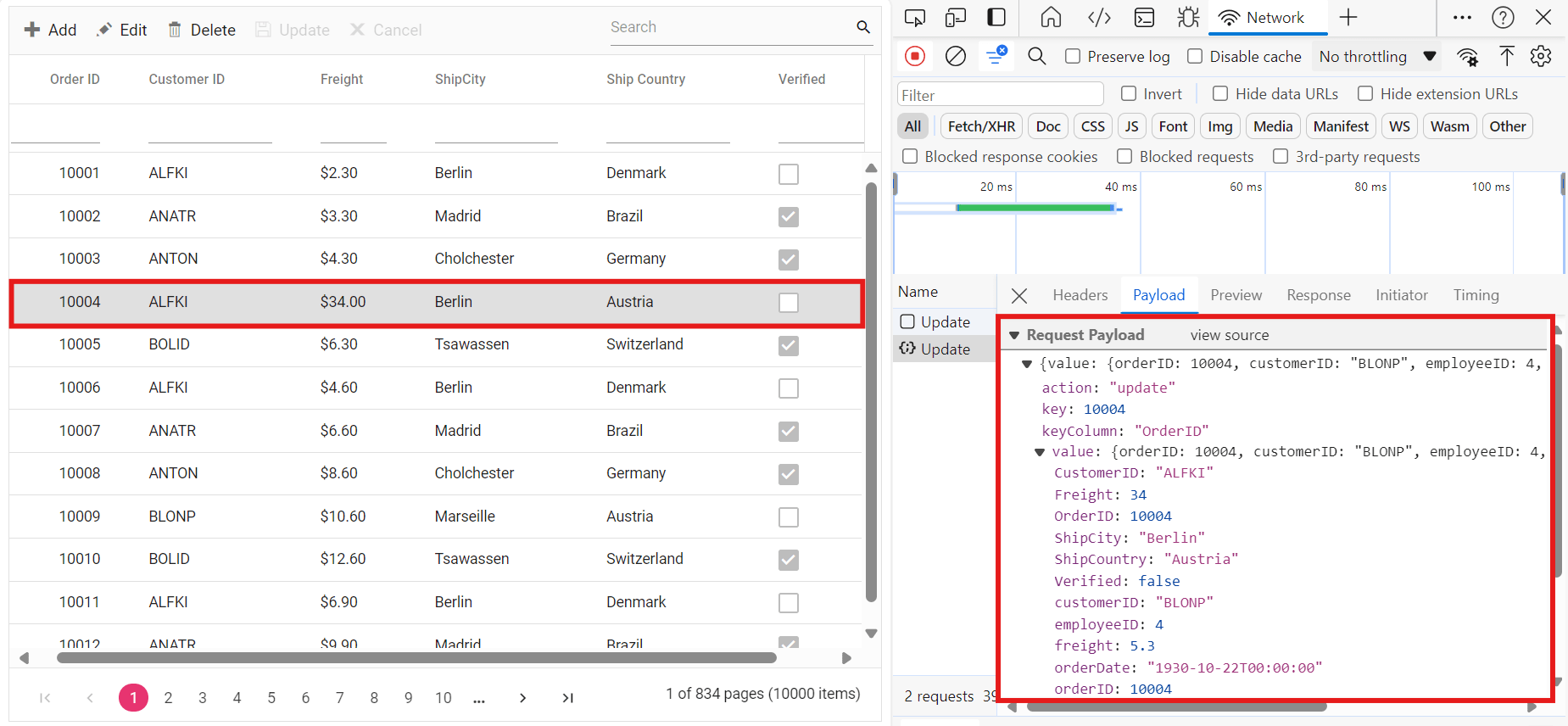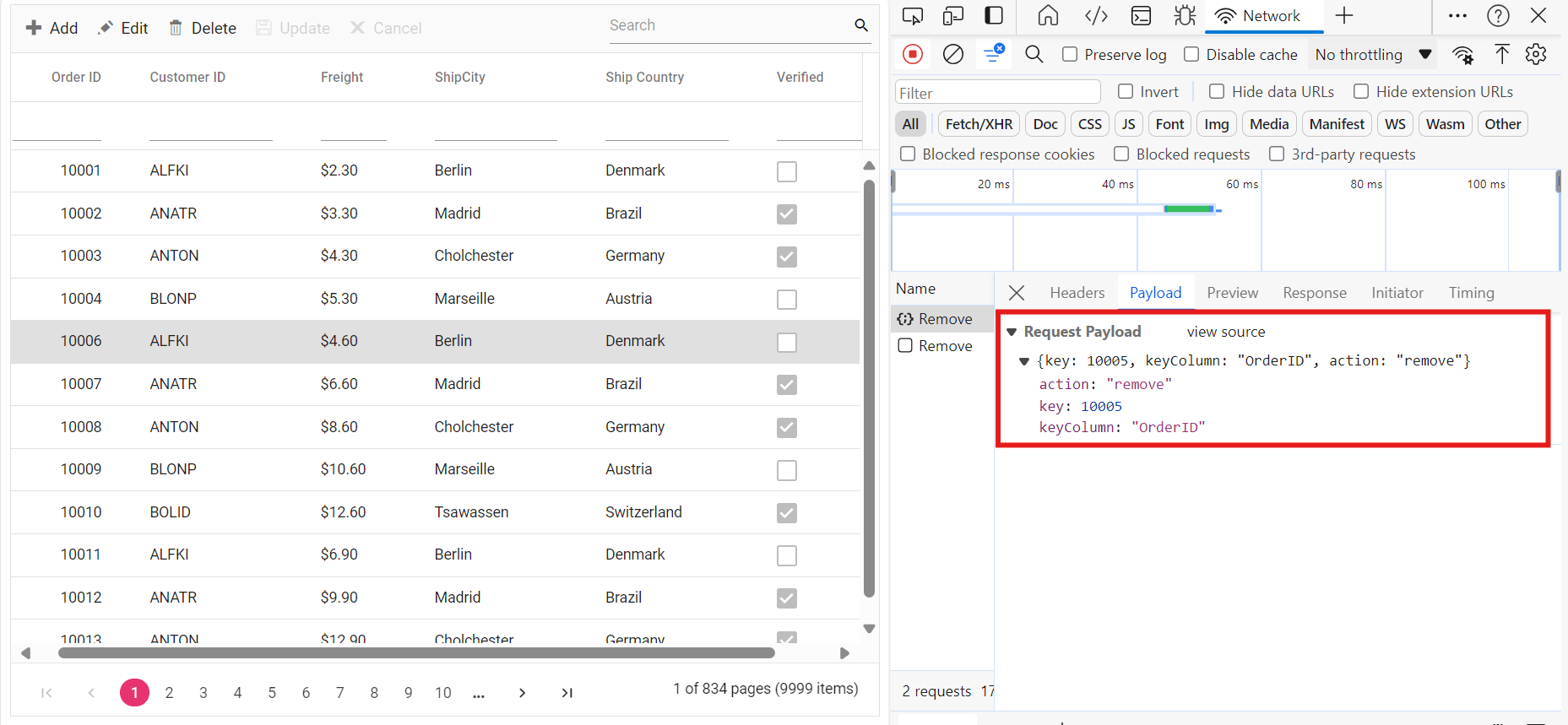Binding and perform CRUD operation using RemoteSaveAdaptor
12 Mar 202519 minutes to read
The RemoteSaveAdaptor in Syncfusion React Grid allows efficient handling of sorting, filtering, searching, and paging primarily on the client-side, while delegating CRUD operations (Create, Read, Update, Delete) to the server-side for data persistence. This approach reduces unnecessary server interactions, improving performance and user experience.
Ensure your server-side implementation in ASP.NET Core handles CRUD operations. Here is an example of how you can set up your ASP.NET Core controller to handle these operations:
Server-Side Implementation
To configure a server with Syncfusion React Grid, you need to follow the below steps:
1. Project Creation:
Open Visual Studio to create a React and ASP.NET Core project named RemoteSaveAdaptor. To create a React and ASP.NET Core application, follow the documentation link for detailed steps.
2. Model Class Creation:
Create a model class named OrdersDetails.cs in the server-side Models folder to represent the order data.
using System.ComponentModel.DataAnnotations;
namespace RemoteSaveAdaptor.Server.Models
{
public class OrdersDetails
{
public static List<OrdersDetails> order = new List<OrdersDetails>();
public OrdersDetails()
{
}
public OrdersDetails(int OrderID, string CustomerId, int EmployeeId, double Freight, bool Verified, DateTime OrderDate, string ShipCity, string ShipName, string ShipCountry, DateTime ShippedDate, string ShipAddress)
{
this.OrderID = OrderID;
this.CustomerID = CustomerId;
this.EmployeeID = EmployeeId;
this.Freight = Freight;
this.ShipCity = ShipCity;
this.Verified = Verified;
this.OrderDate = OrderDate;
this.ShipName = ShipName;
this.ShipCountry = ShipCountry;
this.ShippedDate = ShippedDate;
this.ShipAddress = ShipAddress;
}
public static List<OrdersDetails> GetAllRecords()
{
if (order.Count() == 0)
{
int code = 10000;
for (int i = 1; i <= 2000; i++)
{
order.Add(new OrdersDetails(code + 1, "ALFKI", i + 0, 2.3 * i, false, new DateTime(1991, 05, 15), "Berlin", "Simons bistro", "Denmark", new DateTime(1996, 7, 16), "Kirchgasse 6"));
order.Add(new OrdersDetails(code + 2, "ANATR", i + 2, 3.3 * i, true, new DateTime(1990, 04, 04), "Madrid", "Queen Cozinha", "Brazil", new DateTime(1996, 9, 11), "Avda. Azteca 123"));
order.Add(new OrdersDetails(code + 3, "ANTON", i + 1, 4.3 * i, true, new DateTime(1957, 11, 30), "Cholchester", "Frankenversand", "Germany", new DateTime(1996, 10, 7), "Carrera 52 con Ave. Bolívar #65-98 Llano Largo"));
order.Add(new OrdersDetails(code + 4, "BLONP", i + 3, 5.3 * i, false, new DateTime(1930, 10, 22), "Marseille", "Ernst Handel", "Austria", new DateTime(1996, 12, 30), "Magazinweg 7"));
order.Add(new OrdersDetails(code + 5, "BOLID", i + 4, 6.3 * i, true, new DateTime(1953, 02, 18), "Tsawassen", "Hanari Carnes", "Switzerland", new DateTime(1997, 12, 3), "1029 - 12th Ave. S."));
code += 5;
}
}
return order;
}
[Key]
public int OrderID { get; set; }
public string CustomerID { get; set; }
public int? EmployeeID { get; set; }
public double? Freight { get; set; }
public string ShipCity { get; set; }
public bool? Verified { get; set; }
public DateTime? OrderDate { get; set; }
public string? ShipName { get; set; }
public string? ShipCountry { get; set; }
public DateTime? ShippedDate { get; set; }
public string? ShipAddress { get; set; }
}
}3. API Controller Creation:
Create a file named OrdersController.cs under the Controllers folder. This controller will handle data communication with the Syncfusion React Grid.
using Microsoft.AspNetCore.Mvc;
using RemoteSaveAdaptor.Server.Models;
namespace RemoteSaveAdaptor.Server.Controllers
{
[ApiController]
public class OrdersController : Controller
{
[HttpPost]
[Route("api/[controller]")]
public object Post()
{
// Retrieve data from the data source (e.g., database).
IQueryable<OrdersDetails> DataSource = GetOrderData().AsQueryable();
// Get the total records count.
int totalRecordsCount = DataSource.Count();
// Return data based on the request.
return new { result = DataSource, count = totalRecordsCount };
}
[HttpGet]
[Route("api/[controller]")]
public List<OrdersDetails> GetOrderData()
{
var data = OrdersDetails.GetAllRecords().ToList();
return data;
}
}
}The below class is used to structure data sent during CRUD operations.
public class CRUDModel<T> where T : class
{
public string? action { get; set; }
public string? keyColumn { get; set; }
public object? key { get; set; }
public T? value { get; set; }
public List<T>? added { get; set; }
public List<T>? changed { get; set; }
public List<T>? deleted { get; set; }
public IDictionary<string, object>? @params { get; set; }
}Insert Operation:
To insert a new record, utilize the insertUrl property to specify the controller action mapping URL for the insert operation. Implement the Insert method in the API controller to handle the addition of new records. The details of the newly added record are bound to the newRecord parameter.

/// <summary>
/// Inserts a new data item into the data collection.
/// </summary>
/// <param name="addRecord">The order to be inserted.</param>
/// <returns>It returns the newly inserted record detail.</returns>
[HttpPost]
[Route("api/Orders/Insert")]
public ActionResult Insert([FromBody] CRUDModel<OrdersDetails> newRecord)
{
if (newRecord.value !=null)
{
OrdersDetails.GetAllRecords().Insert(0, newRecord.value);
}
return Json(newRecord.value);
}Update operation:
For updating existing records, use the updateUrl property to specify the controller action mapping URL for the update operation. Implement the Update method in the API controller to handle record updates. The updated record details are bound to the updatedRecord parameter.

/// <summary>
/// Updates an existing order.
/// </summary>
/// <param name="updateRecord">The updated order details.</param>
/// <returns>It returns the updated order details.</returns>
[HttpPost]
[Route("api/Orders/Update")]
public object Update([FromBody] CRUDModel<OrdersDetails> updatedRecord)
{
var updatedOrder = updatedRecord.value;
if (updatedOrder != null)
{
var data = OrdersDetails.GetAllRecords().FirstOrDefault(or => or.OrderID == updatedOrder.OrderID);
if (data != null)
{
// Update the existing record.
data.OrderID = updatedOrder.OrderID;
data.CustomerID = updatedOrder.CustomerID;
data.Freight = updatedOrder.Freight;
data.ShipCity = updatedOrder.ShipCity;
data.ShipCountry = updatedOrder.ShipCountry;
data.Verified = updatedOrder.Verified;
// Update other properties similarly.
}
}
return updatedRecord;
}Delete operation
To delete existing records, use the removeUrl property to specify the controller action mapping URL for the delete operation. The primary key value of the deleted record is bound to the deletedRecord parameter.

/// <summary>
/// Deletes an order.
/// </summary>
/// <param name="deletedRecord">It contains the specific record detail which is need to be removed.</param>
/// <returns>It returns the deleted record detail.</returns>
[HttpPost]
[Route("api/Orders/Remove")]
public object Remove([FromBody] CRUDModel<OrdersDetails> deletedRecord)
{
int orderId = int.Parse(deletedRecord.key.ToString()); // Get key value from the deletedRecord.
var data = OrdersDetails.GetAllRecords().FirstOrDefault(orderData => orderData.OrderID == orderId);
if (data != null)
{
// Remove the record from the data collection.
OrdersDetails.GetAllRecords().Remove(data);
}
return deletedRecord;
}4. Run the Application:
Run the application in Visual Studio. It will be accessible on a URL like https://localhost:xxxx.
After running the application, you can verify that the server-side API controller is successfully returning the order data in the URL(https://localhost:xxxx/api/Orders). Here xxxx denotes the port number.
Connecting a Syncfusion React Grid to a service
To integrate the Syncfusion Grid into your React and ASP.NET Core project using Visual Studio, follow the below steps:
Step 1: Install syncfusion package
Open your terminal in the project’s root directory and install the required Syncfusion packages using npm:
npm install @syncfusion/ej2-react-grids --save
npm install @syncfusion/ej2-data --saveStep 2: Adding CSS reference
Include the necessary CSS files in your App.css file to style the Syncfusion React components:
@import '../node_modules/@syncfusion/ej2-base/styles/material.css';
@import '../node_modules/@syncfusion/ej2-buttons/styles/material.css';
@import '../node_modules/@syncfusion/ej2-calendars/styles/material.css';
@import '../node_modules/@syncfusion/ej2-dropdowns/styles/material.css';
@import '../node_modules/@syncfusion/ej2-inputs/styles/material.css';
@import '../node_modules/@syncfusion/ej2-navigations/styles/material.css';
@import '../node_modules/@syncfusion/ej2-popups/styles/material.css';
@import '../node_modules/@syncfusion/ej2-splitbuttons/styles/material.css';
@import '../node_modules/@syncfusion/ej2-react-grids/styles/material.css';Step 3: Adding Syncfusion Grid
In your component file (e.g., App.tsx), import DataManager and RemoteSaveAdaptor from @syncfusion/ej2-data. Create a DataManager instance by following these steps:
-
Assign RemoteSaveAdaptor: Set the
adaptorproperty within the dataSource configuration to new RemoteSaveAdaptor(). This enables server-side CRUD operations for your Grid. -
Set dataSource Property: Configure the
dataSourceproperty of your Syncfusion React Grid with a JSON object. -
CRUD Operations Mapping: CRUD operations within the Grid can be mapped to server-side controller actions using specific properties:
- insertUrl: Specifies the URL for inserting new data.
- removeUrl: Specifies the URL for removing existing data.
- updateUrl: Specifies the URL for updating existing data.
- crudUrl: Specifies a single URL for all CRUD operations.
- batchUrl: Specifies the URL for batch editing.
In this example, data is fetched by the server using fetch method and assign it to the dataSource property.
import React, { useEffect, useState } from "react";
import { GridComponent, ColumnsDirective, ColumnDirective, Inject, Toolbar, Edit, Page, Sort, Filter } from "@syncfusion/ej2-react-grids";
import { DataManager, RemoteSaveAdaptor } from "@syncfusion/ej2-data";
import "./App.css";
const serviceUrl = "https://localhost:xxxx/api/Orders"; // Replace with your API URL.
const App = () => {
const [data, setData] = useState(null);
useEffect(() => {
fetch(serviceUrl)
.then((response) => response.json())
.then((result) => {
setData(new DataManager({
json: result,
adaptor: new RemoteSaveAdaptor(),
updateUrl: `${serviceUrl}/Update`,
insertUrl: `${serviceUrl}/Insert`,
removeUrl: `${serviceUrl}/Remove`,
}));
})
.catch((error) => console.error("Error fetching data:", error));
}, []);
const editSettings = {
allowEditing: true,
allowAdding: true,
allowDeleting: true,
newRowPosition: "Top",
};
const toolbarOptions = ["Add", "Edit", "Delete", "Update", "Cancel", "Search"];
return (
<div>
{data && (
<GridComponent id="grid" dataSource={data} editSettings={editSettings} toolbar={toolbarOptions} allowSorting={true} allowPaging={true} allowFiltering={true}>
<ColumnsDirective>
<ColumnDirective field="OrderID" headerText="Order ID" textAlign="Right" width="120" isPrimaryKey={true} />
<ColumnDirective field="CustomerID" headerText="Customer ID" width="150" />
<ColumnDirective field="ShipCity" headerText="Ship City" width="150" />
<ColumnDirective field="ShipName" headerText="Ship Name" width="150" />
</ColumnsDirective>
<Inject services={[Toolbar, Edit, Page, Sort, Filter]} />
</GridComponent>
)}
</div>
);
};
export default App;Replace https://localhost:xxxx/api/Orders with the actual URL of your API endpoint that provides the data in a consumable format (e.g., JSON).
Run the application in Visual Studio. It will be accessible on a URL like https://localhost:xxxx.
Ensure your API service is configured to handle CORS (Cross-Origin Resource Sharing) if necessary.
[program.cs] builder.Services.AddCors(options => { options.AddDefaultPolicy(builder => { builder.AllowAnyOrigin().AllowAnyMethod().AllowAnyHeader(); }); }); var app = builder.Build(); app.UseCors();